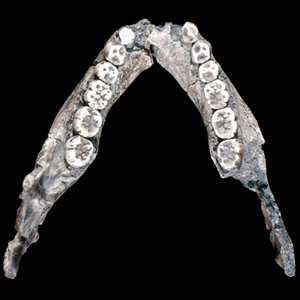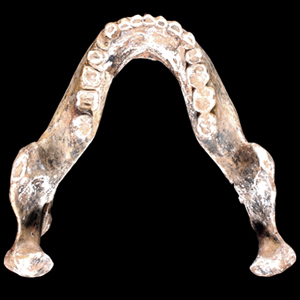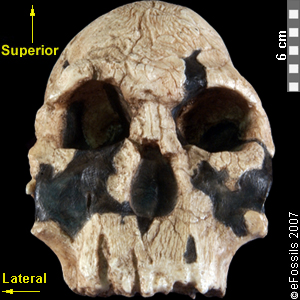when an animal assumes a form of bipedalism on a permanent basis due to habit or anatomy.
a bifacial stone core tool probably used for cutting and chopping; associated with the Acheulean tradition.
an epoch in the Cenozoic period on the geologic time scale that approximately dates from 10,000 years ago to the present; marked by the domination of Homo sapiens.
a term most commonly used to describe humans and our bipedal fossil relatives to the exclusion of the other large apes. In a formal sense, hominid reflects a classification that groups humans and their bipedal fossil relatives in the family Hominoidea to the exclusion of the apes who are placed in the families Hylobatidae (gibbon, siamangs) and Pongidae (orangutan, chimpanzee, bonobo, gorilla).
a term most commonly used to informally describe the apes (gibbon, siamang, orangutan, chimpanzee, bonobo, gorilla). In a formal sense, hominoid reflects a classification that places the large apes in the family Pongidae, the small apes in the family Hylobatidae, humans and their bipedal fossil relatives in the family Hominidae, and groups all of these in the superfamily Hominoidea. Under this scheme, all of these species are hominoids but the term is usually restricted to the apes only.
a genus dating back 2.5 million years, that includes modern humans (i.e., Homo sapiens) and other extinct species, including Homo habilis, Homo ergaster, Homo erectus, Homo antecessor, Homo heidelbergensis (i.e., Archaic Homo sapiens), and Homo neaderthalensis; characterized as the first hominin to radiate outside of the African continent, an increase in brain and body size, and is the first hominin associated with stone tool use.
an extinct hominin species that existed approximately 800,000 years ago; fossil remains found at Atapuerca in Spain indicate Homo antecessor had an increased brain size (approximately 1,000 cubic centimeters), a flattened face, a deep fossa between the nasal aperture and the cheek bone, and large canines and incisors. Some scientists suggest H. antecessor may be the last common ancestor of modern humans and Neanderthals, through Homo heidelbergensis, because they appear to have a combination of primitive traits found in earlier Homo forms and derived features not seen in either Neanderthals or Homo sapiens. The type specimen for H. antecessor is ATD 6-5 found at Atapuerca and dates to approximately 780,000 years ago.
an extinct hominin species that existed approximately 1.8 million years ago to 200,000 years ago; possibly the first hominin to migrate out of Africa; fossil remains found at Koobi Fora in Kenya, Dmanisi in Georgia, Zhoukoudian in China, and at Java in Indonesia indicate that Homo erectus has an increased body and brain size (850-1250 cc) and distinct sexual dimorphism. H. erectus also had a pronounced brow ridge, a slightly prognathic face, an elongated cranium and small cheek teeth. H. erectus is associated with manufacturing Acheulian stone tools. The type specimen for H. erectus is Trinil 2 found in Java and dates from 1 million to 700,000 years old. .

an extinct hominin species that existed approximately 2 million years ago to 1.5 million years ago; dispersal of Homo ergaster is limited to the continent of Africa; fossil remains found at Olduvai Gorge, East Turkana, and possibly Swartkrans in South Africa, indicate Homo ergaster had an absolute brain size of 500 to 600 cubic centimeters, an increased body size, rounded brain case, a small prognathic face, pronounced brow ridge, and small teeth. H. ergaster shows definite sexual dimorphism; very few post-cranial remains have been found. The type specimen for H. ergaster is KNM-ER 992, found at Koobi Fora and dates to approximately 1.5 million years ago. One of the most famous H. ergaster fossil is KNM-WT 15000 (or "Turkana Boy") found at Nariokotome, Kenya, and dates to 1.6 million years ago.
an extinct hominin species that existed approximately 2.5 million years ago to 1.6 million years ago; fossil remains found at several sites (e.g., Olduvai Gorge, Koobi Fora, Hadar, Lake Baringo, and Uraha) indicate Homo habilis had a relatively small brain, reduced canines, and small molars; nicknamed "handy man" because the first good evidence of stone tool manufacture and use by humans is associated with H. habilis remains; marked by the first definite evidence for an expansion in absolute brain size that is clearly beyond the ape range. Some argue the size difference between H. habilis and Homo rudolfensis may actually be a result of sexual dimorphism, and therefore H. rudolfensis may be of the same species as H. habilis. The type specimen for H. habilis is OH 7, found at Olduvai Gorge and dates to approximately 1.75 million years ago.

[see also Archaic Homo sapiens] an extinct hominin species that existed approximately 600,000 years ago to 200,000 years ago; fossils found in Africa (e.g., Bodo, Kabwe, Ilert, and El Hajeb), Asia (e.g., Junniushan, Narmada, and Dali), and Europe (e.g., Sima de los Huesos, Mauer, Petralona, Arago, Steinheim, Swanscombe, and Boxgrove) indicate Homo heidelbergensis retained many primitive traits such as a large face and separated brow ridge, but also shows an increase in brain size (1100-1300 cc), and a frontal bone and cranial base more similar to that of anatomically modern humans. H. heidelbergensis is associated with the first evidence of spear use. There is disagreement over whether H. heidelbergensis is a separate species (i.e., Archaic H. sapiens). The type specimen for H. heidelbergensis is Mauer 1, found near Heidelberg, Germany and dates to approximately 500,000 years ago.
an extinct hominin species that existed in Europe and western Asia from 150,000 to 35,000 years ago. Homo neaderthalensis stature and brain size were comparable with modern humans, but certain features of their anatomy, such as large noses and a robust skeleton, may have been adaptations to Ice Age climates. Neanderthal burials show evidence of cultural treatment of the dead. H. neanderthalensis may have been replaced by successive radiations of H. sapiens into Europe.

an extinct African hominin species that existed approximately 2.4 million years ago to 1.6 million years ago; fossil remains found at Koobi Fora in East Turkana (Kenya) are very similar to Homo habilis but with a much larger brain (751 cubic centimeters), more flattened face and presumably larger body size. Some argue the size difference between Homo rudolfensis and H. habilis may actually be a result of sexual dimorphism, and therefore H. rudolfensis may be of the same species as H. habilis. The type specimen for H. rudolfensis is KNM-ER 1470 found at Koobi Fora and date to 1.8 million years ago.
anatomically modern humans; an extant hominin species that evolved approximately 200,000 years ago to continues to exists in the present; Homo sapiens fossils have been recovered all over the globe, though the earliest fossils have been found at Omo Kibish, Herto, Klasies River Mouth, Skhul, and Qafzeh. Diagnostic traits for H. sapiens include a relatively large brain size (about 1350 cc), a globular cranium, a continuous brow ridge, little to no prognathism of the face, and the presence of a chin. Post-cranially, H. sapiens is fully bipedal, have long limbs and a relatively short trunk, and appear to have decreased in body size around 35,000 years ago. Evidence suggests H. sapiens replaced H. erectus regionally over several hundred thousand years. H. sapiens is associated with Middle and Upper Paleolithic tools; argued to be the first logistical hunters.
[adj. homologous] characters shared as a result of common ancestry.
characters that are similar but not the result of common ancestry; may be a result of convergent evolution and/or parallel evolution.
eFossils is a collaborative website in which users can explore important fossil localities and browse the fossil digital library. If you have any problems using this site or have any other questions, please feel free to contact us.
Funding for eFossils was provided by the Longhorn Innovation Fund for Technology (LIFT) Award from the Research & Educational Technology Committee (R&E) of the IT governance structure at The University of Texas at Austin.
